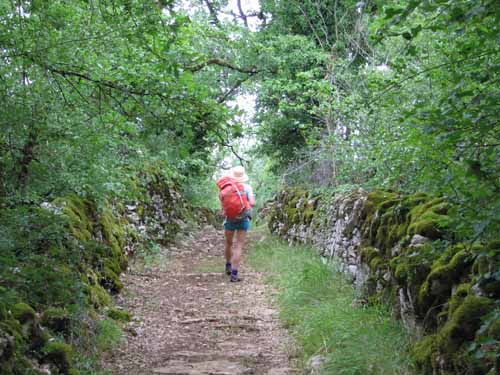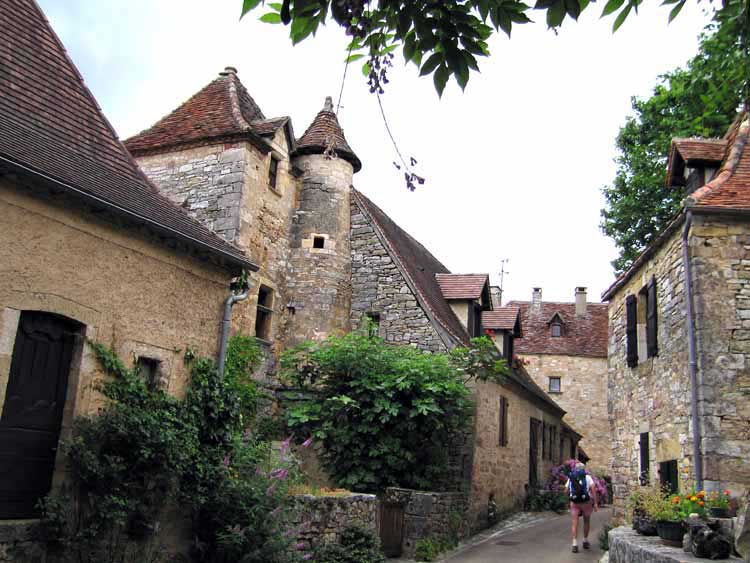Thursday, 7 July 2005
Distance 21 km
Duration 4 hours 30 minutes
Ascent 477 m, descent 273 m
Map 48 of the
Once again we had a leisurely start. We collected our baguette from the office and set off along the road to find the place where the GR comes down from above, as we had done two years ago, but somehow we missed the place and in no time found ourselves at Gintrac.
The advantage of this was that there was a hotel on the corner, where we had large bowls of coffee and a look at yesterday’s paper in the sunny interior.
They were setting up dozens of tables for lunch, presumably for the passing trade, as the village itself looked tiny.
To our surprise, as we walked up the side road from the hotel, we came to the real village, tucked away in a glen, perhaps to be out of sight of marauding Vikings on the river. It seemed to be having a rebirth after a period of decay.
A bit higher up we reconnected with the lost GR and followed it comfortably along the top of the ridge, until we reached a parting of the ways.
One track went straight to Loubressac and the other diverged to Padirac, where there was a famous sinkhole (“gouffre”) that we wanted to see.
We could see that the way we were on had been a main thoroughfare in the days before cars, as it was expertly cobbled and walled with white stone, patched with moss. Beyond the walls, the forest stretched away on both sides.
It was odd to emerge from this quiet old path into the madhouse of the Gouffre, where rows of cars filled a vast carpark and a dozen eateries were doing frantic trade.
The Gouffre was closed for lunch until
The day was cold and cloudy so everybody was crowded inside. Before we actually got served, it was time to go, so we did without coffee but were grateful for the warmth and comfort of the bar.
When we arrived at the ticket office, an untidy crowd was sitting on the steps, waiting for the grille to be raised.
Beside it the shockingly deep hole could be seen through the fence, with various rickety pieces of machinery descending to the floor and across it. The last of the morning visitors looked like ants.
We asked at the ticket office and also at the gift shop, but neither wanted to mind our packs while we took the tour (€8.30 each), so we made nuisances of ourselves for the duration, taking up twice the space.
After descending in metal lifts into the depths of the earth, we walked down a ramp in a natural tunnel and came to an inky lake, completely still, reflecting ghostly lights. We glided in gondolas over its glassy surface as our ferryman kept up a soothing sing-song of information.
Then we were shepherded into a mind-boggling chamber with a 95m high domed roof, and back past a hanging lake and an array of weird and fanciful formations.
We were up on the surface just after 3 o’clock and it was no warmer than down below, namely 13 degrees, but a bit of brisk exertion on the GR got our blood circulating.
A loud hammering in the forest turned out to be a trench-digger laying pipes, and it was instructive to see that it was turning up not soil, but cracked white rock, the porous, infertile substance of the causse. How the forest could grow so well on it was hard to imagine.
Approaching Loubressac, we saw the camping ground, but kept going into the village to have the coffee we had missed out on at the Gouffre.
We had it in the sunshine at the excellent Logis de France hotel in the square, and while we were at it, we made a booking for dinner there.
At the camping ground there was a woman on the desk who asked us where we were from. Lately I had fallen into the habit of specifying that we were neither English nor American, as these two nations did not seem to be popular in France – the former because of long-standing rivalry and the latter because of Bush.
To our astonishment the woman replied “Je suis americaine”. I said I could not believe it, whereupon she uttered, in a deep south accent, the single statement “Ah’m serious!”, immediately reverting to French. She had lived in France for 25 years and had a French husband and child.
Having made ourselves comfortable with showers and a siesta, we returned to the village, which occupies a promontory at the edge of the causse, high above the fertile river flats.
Even though it only consists of a few lanes, it richly deserves its classification as a Plus Beau Village, which is more than can be said for some of them.
In the restaurant we sat near a window with an ample view of the valley of the Dordogne. With our preliminary glasses of rosé we had a cold smoked salmon salad and followed it with rare steaks and pommes sarladaises, the prevailing potato dish in this area.
We had cheese with the remainder of our red wine and finished off with coffee icecream and fruit.
The waiter definitely had Neanderthal blood in his veins. I quite took to his coarse, gentle face, so incongruous with the formal suit and tie he was wearing.








